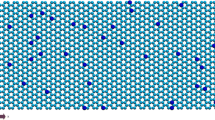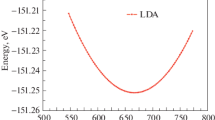A molecular structural mechanics approach is used to study the effect of double-atom vacancy defects (DAVD) on the elastic properties of zigzag and armchair single-layered graphene sheets (SLGS). To this end, the space frame structure is also adopted to model the interatomic forces of the C–C bonds. The numerical simulation results obtained via the finite element method strongly suggest that double-atom vacancy defects reduce the elastic module of SLGS, which effect weakens with graphene size. Finally, the elastic modulus and Poisson’s ratio of SLGS are found to decrease with the number of DAVDs.






Similar content being viewed by others
References
K. S. Novoselov, A. K. Geim, S. V. Morozov, et al., “Electric field effect in atomically thin carbon films,” Science, 306, No. 5696, 666–669 (2004).
A. P. Yu, P. Ramesh, M. E. Itkis, et al., “Graphite nanoplatelet-epoxy composite thermal interface materials,” J. Phys. Chem. C, 111, No. 21, 7565–7571 (2007).
C. Lee, X. D. Wei, J.W. Kysar, and J. Hone, “Measurement of the elastic properties and intrinsic strength of monolayer graphene,” Science, 321, No. 5887, 385–388 (2007).
F. Banhart, J. Kotakoski, and A. V. Krasheninnikov, “Structural defects in graphene,” ACS Nano, 5, No. 1, 26–41 (2011).
Q. X. Pei, Y. W. Zhang, and V. B. Shenoy, “A molecular dynamics study of the mechanical properties of hydrogen functionalized graphene,” Carbon, 48, No. 3, 898–904 (2010).
H. Bu, Y. F. Chen, M. Zou, et al., “Atomistic simulations of mechanical properties of graphene nanoribbons,” Phys. Lett. A, 373, No. 37, 3359–3362 (2009).
F. Liu, P. B. Ming, and J. Li, “Ab initio calculation of ideal strength and phonon instability of graphene under tension,” Phys. Rev. B, 76, No. 6, 064120-1–064120-7 (2007).
C. D. Reddy, S. Rajendran, and K. M. Liew, “Equilibrium configuration and continuum elastic properties of finite sized graphene,” Nanotechnology, 17, No. 3, 864–871 (2006).
C. Li and T. W. Chou, “A structural mechanics approach for the analysis of carbon nanotubes,” Int. J. Solids Struct., 40, No. 10, 2487–2499 (2003).
K. Machida, Principles of Molecular Mechanics, Kodansha and John Wiley & Sons Co-publication, Tokyo–New York (1999).
A. K. Rappe, C. J. Casewit, K. S. Colwell, et al., “UFF, a full periodic table force field for molecular mechanics and molecular dynamics simulations,” J. Am. Chem. Soc., 114, No. 25, 10024–10035 (1992).
W. D. Cornell, P. Cieplak, C. I. Bayly, et al., “A second generation force field for the simulation of proteins, nucleic acids, and organic molecules,” J. Am. Chem. Soc., 117, No. 19, 5179–5197 (1995).
G. M. Odegard, T. S. Gates, K. E. Wise, et al., “Constitutive modeling of nanotube- reinforced polymer composites,” Compos. Sci. Technol., 63, No. 11, 1671–1768 (2002).
M. S. Dresselhaus, G. Dresselhaus, and R. Saito, “Physics of carbon nanotubes,” Carbon, 33, No. 7, 883–891 (1996).
H. Wan and F. Delale, “A structural mechanics approach for predicting the mechanical properties of carbon nanotubes,” Meccanica, 45, No. 1, 43–51 (2010).
Acknowledgments
This work was supported by the National Natural Science foundation of China (Nos. 11602066, 11472086, and 11532013) and the China Postdoctoral Science Foundation on the 56th bath of surface founds the project (2014M561327) and the National Science Foundation of Heilongjiang Province of China (QC2015058 and 42400621-1-15047), the Foundation Research Funds for the Central Universities.
Author information
Authors and Affiliations
Corresponding authors
Additional information
Translated from Problemy Prochnosti, No. 6, pp. 157 – 164, November – December, 2017.
Rights and permissions
About this article
Cite this article
Wang, Z.Q., Yu, Z.W., Sun, X.Y. et al. Effect of Double-Atom Vacancy Defects on the Elastic Properties of Single-Layered Graphene Sheets. Strength Mater 49, 865–871 (2017). https://doi.org/10.1007/s11223-018-9932-6
Received:
Published:
Issue Date:
DOI: https://doi.org/10.1007/s11223-018-9932-6




